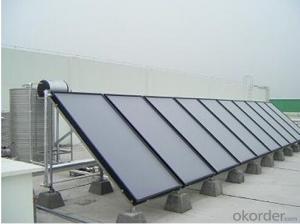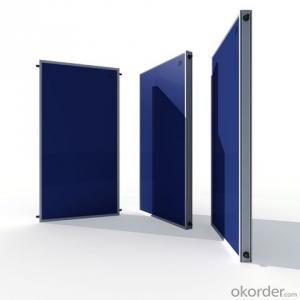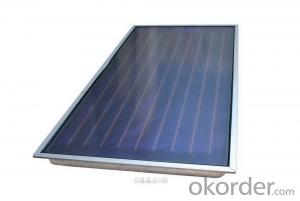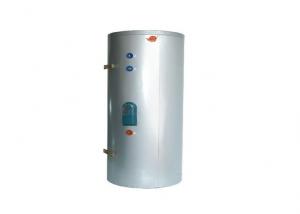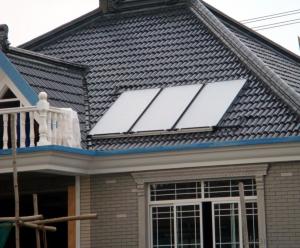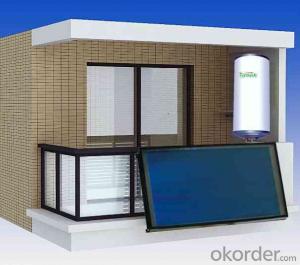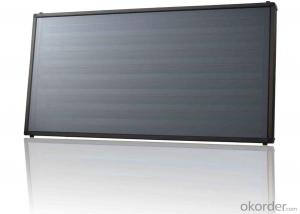Flat Plate for Solar Collector Model SDT3.0-A/C Series
- Loading Port:
- Shanghai
- Payment Terms:
- TT OR LC
- Min Order Qty:
- 50 pc
- Supply Capability:
- 300 pc/month
OKorder Service Pledge
OKorder Financial Service
You Might Also Like
1. Structure of Flat Plate for Solar Collector Model SDT3.0-A/C Series
This flat plate comprises strong low Iron tempered textured glass and absorber plate of different thickness and frame style for option, and risers and headers comform to international standard; for the back plate,it is constructed with galvanized steel and the frame is extruded with anodized aluminum alloy. This product is smart in appearance and get good quality.

1.glazing, 2. absorber plate, 3. risers, 4. insulation, 5. casing
2. Main Features of Flat Plate for Solar Collector Model SDT3.0-A/C Series
low iron tempered textured glass can maximize the solar radiation available and minimize energy emittance
risers designed for either water or propylene glycol
good corrosion resistance and light handling capbilities
3. Flat Plate for Solar Collector Model SDT3.0-A/C Series Images

4. Flat Plate for Solar Collector Model SDT3.0-A/C Series Specifications
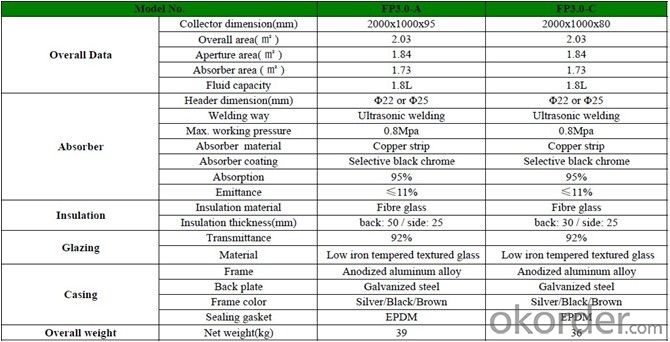
5. FAQ
Q1.: What is the respective diameter of the risers and heads?
Re: For the risers the diameter is 22mm &25mm and for the heads 10mm.
Q2.: What is the insulation of this product?
Re: Fiber glass is used to insulate the base of the collector to minimize heat loss. It has 30mm to 50mm thickness for option and has a conductivity <0.048W/(m.K).
- Q:What is the average lifespan of a solar collector?
- The average lifespan of a solar collector is typically around 20 to 30 years. However, with proper maintenance and regular inspections, some solar collectors can last even longer, up to 40 years or more.
- Q:Can solar collectors be used in transportation?
- Yes, solar collectors can be used in transportation. Solar energy can be harnessed through solar collectors and converted into electricity to power electric vehicles or used to charge their batteries. This renewable energy source can help reduce reliance on fossil fuels and decrease carbon emissions in the transportation sector.
- Q:How do parabolic trough solar collectors work?
- Parabolic trough solar collectors work by using curved mirrors to concentrate sunlight onto a receiver tube located at the focal point of the parabolic shape. The receiver tube contains a working fluid, such as oil or water, which gets heated up by the concentrated solar energy. This hot fluid is then used to generate steam, drive a turbine, and produce electricity. The parabolic shape of the collectors allows them to track the movement of the sun, maximizing the amount of sunlight they can capture throughout the day.
- Q:Are solar collectors cost-effective?
- Yes, solar collectors are cost-effective in the long run. Although the initial investment may be higher compared to traditional energy sources, the long-term savings on electricity bills and the potential for government incentives make solar collectors a financially viable option. Additionally, the decreasing cost of solar technology and the ability to generate clean and renewable energy contribute to their overall cost-effectiveness.
- Q:Can solar collectors be used in areas with high air pollution?
- Yes, solar collectors can still be used in areas with high air pollution. Although air pollution can reduce the efficiency of solar panels by blocking sunlight, advancements in technology have made solar panels more resilient to these conditions. Additionally, regular cleaning and maintenance can help mitigate the impact of air pollution on the performance of solar collectors.
- Q:Can solar collectors be used in combination with desalination systems?
- Yes, solar collectors can be used in combination with desalination systems. Solar energy can be harnessed to power the desalination process, providing a sustainable and renewable source of energy. This combination offers an environmentally friendly solution to address water scarcity by utilizing solar power to operate desalination systems and produce freshwater from saltwater sources.
- Q:Can solar collectors be used for heating driveways?
- Yes, solar collectors can be used for heating driveways. Solar collectors, such as solar thermal panels, can absorb sunlight and convert it into heat energy. This heat energy can be used to warm up a fluid, such as water or antifreeze solution, which can then be circulated through pipes embedded in the driveway to heat it. This can help melt snow and ice during winter, making driveways safer and easier to navigate.
- Q:Can solar collectors be used in landfill gas-to-energy plants?
- Yes, solar collectors can be used in landfill gas-to-energy plants. Landfill gas-to-energy plants utilize the methane gas produced by the decomposition of organic waste in landfills to generate electricity or heat. Solar collectors can be integrated into these plants to supplement the energy generated from the landfill gas. They can be used to capture solar energy and convert it into electricity, which can be used for various purposes within the plant or injected into the grid. This combination of solar and landfill gas energy sources can enhance the overall efficiency and sustainability of the plant, making it more environmentally friendly and reducing reliance on fossil fuels.
- Q:Can solar collectors be used for heating train stations?
- Yes, solar collectors can be used for heating train stations. Solar thermal systems can be installed to capture the sun's energy and convert it into heat, which can then be used to heat the train station buildings or water for heating purposes. This renewable energy source can help reduce dependence on fossil fuels and contribute to a more sustainable and environmentally friendly heating solution for train stations.
- Q:Are there any financial incentives for installing solar collectors?
- Yes, there are several financial incentives available for installing solar collectors. These incentives vary by country and region but can include tax credits, grants, rebates, and net metering programs. Additionally, installing solar collectors can lead to significant long-term savings on energy bills by reducing reliance on traditional energy sources.
1. Manufacturer Overview |
|
|---|---|
| Location | |
| Year Established | |
| Annual Output Value | |
| Main Markets | |
| Company Certifications | |
2. Manufacturer Certificates |
|
|---|---|
| a) Certification Name | |
| Range | |
| Reference | |
| Validity Period | |
3. Manufacturer Capability |
|
|---|---|
| a)Trade Capacity | |
| Nearest Port | |
| Export Percentage | |
| No.of Employees in Trade Department | |
| Language Spoken: | |
| b)Factory Information | |
| Factory Size: | |
| No. of Production Lines | |
| Contract Manufacturing | |
| Product Price Range | |
Send your message to us
Flat Plate for Solar Collector Model SDT3.0-A/C Series
- Loading Port:
- Shanghai
- Payment Terms:
- TT OR LC
- Min Order Qty:
- 50 pc
- Supply Capability:
- 300 pc/month
OKorder Service Pledge
OKorder Financial Service
Similar products
New products
Hot products
Hot Searches
Related keywords
